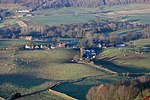Warren Moor Mine
Ironstone Mines in North YorkshireMines in North YorkshireMining in North YorkshireRedcar and ClevelandUnderground mines in England ... and 1 more
Use British English from February 2021

The Warren Moor Mine, was a short-lived mining concern south of Kildale, North Yorkshire, England. Activity at the site was limited to drift mining, and although shafts were sunk to mine the underground schemes, these ventures failed. The site of the workings have been stabilised, and the old chimney is the only Victorian ironstone mining chimney left in the United Kingdom. The site was made safe in the 2010s to allow public access.
Excerpt from the Wikipedia article Warren Moor Mine (License: CC BY-SA 3.0, Authors, Images).Warren Moor Mine
Green Gate Lane,
Geographical coordinates (GPS) Address Nearby Places Show on map
Geographical coordinates (GPS)
| Latitude | Longitude |
|---|---|
| N 54.471 ° | E -1.037 ° |
Address
Green Gate Lane
YO21 2RX
England, United Kingdom
Open on Google Maps










